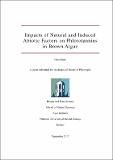| dc.description.abstract | Phlorotannins are a group of highly bioactive marine polyphenols found exclusively in brown algae. They play multiple ecological roles in algae inhabiting stressful environments and, as a result, their natural concentrations display a high degree of variability, making the determination of the specific factors driving their metabolism challenging. Their reactivity, which has hindered their elucidation to date, is largely responsible for the unprecedented commercial attention they have received over the last few decades. Owing to their structural complexity, little is known regarding their biosynthesis, as well as the chemical properties responsible for their activity, such as degree of polymerisation and isomerisation, which can influence the availability of active hydroxyl units. Moreover, the use of several nonstandardised methods has prevented cross-comparison of studies, thus the factors responsible for their natural variation are still uncertain.
This study aimed to assess the natural variability of low molecular weight phlorotannin-enriched fractions for selected species of brown algae, in an effort to clarify the primary environmental factors causing changes in their profiles. An integrated approach of both field sampling and laboratory-controlled experiments was employed to attain a more in-depth understanding of the effects abiotic factors impose on phlorotannin chemistry. This involved the comparative investigation of season, location, inter-species and intra-thallus variability within four brown algae; Pelvetia canaliculata, Ascophyllum nodosum, Fucus vesiculosus and Himanthalia elongata. Specifically, due to the potential it displays for commercial development, F. vesiculosus was further examined under short-term culture conditions, to assess the specific effects of irradiance, nitrogen and temperature on LMW phlorotannin profiles. The effects of experimentally-induced abiotic factors on the overall algal physiology were assessed, through measuring Chl a fluorescence, along with changes incurred to the LMW phlorotannin chemical composition, content and associated antioxidant activity, to better understand the mechanisms behind their variability.
The results of this study demonstrate LMW phlorotannins to be effective radical scavengers and promising candidates for commercial integration. The degree of activity varies between species, owing to their distinct chemical profiles, possibly arising through genetic evolution. However, these compounds display rapid turnover rates, with shifts in the concentrations observed in response to environmental parameters, particularly light and temperature. The impact of such factors on phlorotannin metabolism is likely to stem from their effect on key components involved in the expression and regulation of their biosynthetic pathway, as well as their subsequent degradation and oxidation. The results highlight the ecological importance of these compounds, particularly within intertidal species, functioning to provide a heightened degree of tolerance of diurnal fluctuations in irradiance and temperature levels. The results attained here provide a solid foundation of valuable scientific information on which future research can be readily established. | en_IE |


